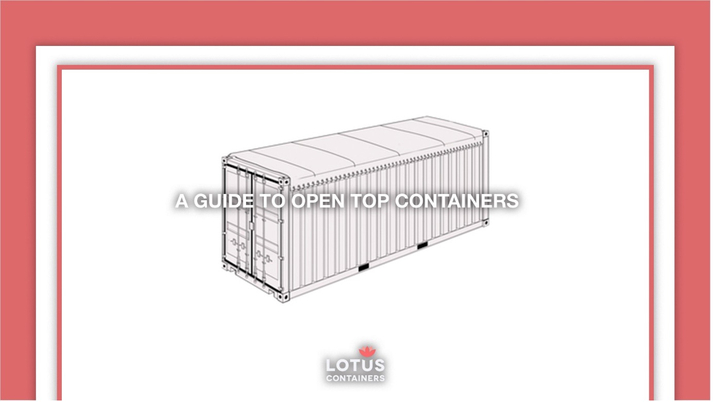Before we discuss open top containers in detail, let’s go back to history when the container was alien to humans.
Evolution of Containers
The shipping container has been the single biggest catalyst of globalization. But there were days when shipping used to be extremely challenging. Goods were just wrapped and packed somehow inside drums, barrels, sacks, bucket and set for sailing. Half of the items would get rot and robbed before they could reach the destination. Lack of safety was a major concern and would often lead to loss of cargoes. Also, the entire process was mostly carried using manual efforts. It would take up to 3 weeks to unload and load each ship. It was slow, tedious, and inefficient.
The revolution hit mankind in 1956 when the first invention was made by an American Entrepreneur Malcolm McLean. It was then when for the very first-time shipping containers came into existence. The slow and tedious shipping got pace and started to be carried with much efficiency post the invention of containers. Ever since then, various modifications were made in its design, dimension, and structure, and thereafter several different types of containers were made to suit the shipment of all types of cargoes like dry van, pallet wide, reefer, flat rack, open-top containers, to name a few.
Open Top Containers – Introduction
Open top container is one of the different types of shipping containers. It serves similar storage and shipment purposes as general cargo boxes. Built to store large unwieldy cargoes that cannot be transported in an enclosed box, open-top comes to rescue for such cargoes. There is not so much open top container available around the world which often makes it expensive to buy or lease one. Also, the cost varies as per the type of cargo you bring to ship in them. Container suppliers like LOTUS Containers can provide these facilities around the globe.
Design and Structure
It is manufactured from corrugated steel and has wooden flooring. As the name itself says, the top of the box is open and is covered using a strong rubber tarpaulin instead of a solid roof. The tarpaulin is secured with a removable rail that keeps the cover in its place. The moveable rear top rail performs two functions at a time- supports the tarpaulin and increases the stability of the container. Reinforcement runs along all four sides to maintain its rigidity and provide support from all sides.
The interior of an open top box can be accessed through doors on either end of the box. In cases when cargo fits the dimension well enough, the tarpaulin remains plane horizontal, and thus containers can be easily stacked on top of it. However, the stacking is not possible in case the cargo exceeds the height of the box. It also has lashing rings that can keep the cargo stable despite the height and weight of the cargoes. It is installed in the upper and lower side rails and the corner posts. Lashing rings generally can withstand a load of up to 1,000 kg.
It’s important to measure the volume of the items to be loaded to ensure that they will fit perfectly inside the container. Cargo that fit perfectly inside the box is charged lesser in comparison to cargoes that protrude beyond the container’s height.
Dimensions play a significant role while selecting a unit. The size of OT varies between manufacturers. But mostly OT comes in two different dimensions-
20ft Open Top
- Internal dimension- 19’3×7’8×7’7
- External dimension- 19’10x8x8’6
- Door opening- 7’8×7’5
- Max gross weight- 67200 pounds
40ft Open Top
- Internal dimension- 39’5×7’8×7’7
- External dimension- 40x8x8’6
- Door opening- 7’8×7’5
- Max gross weight- 67200 pounds
For decades, open top container is being used to ship large cargo. They help with the cargo that most other boxes wouldn’t be able to. They offer a larger capacity than a normal standard shipping container. Its capacity allows it to carry around 30 tons. Goods like construction material, machinery, iron rods can be easily carried in them.
Some Common features of open top containers-
- It makes the handling of heavy and awkward cargoes easy
- It provides two loading options- main door and from top
- It has wooden flooring
- It includes securing points on bottom side rails and floor
- It has a tarpaulin that covers the cargo from top
Uses of Open Top Containers
They are extremely useful for loading scrap metal and large timber trunks that other boxes often fail to load and ship. Companies have been utilizing these boxes for shipping large and wide cargoes that can be loaded easily from top using a crane or forklift. Loading and unloading easily get done. Most commonly shipped items-
- Scrap materials
- Long steel bars and rods of varying thickness
- Ore, coal, and other raw mining materials
- Cable spools and cables
- Big Size tree trunk
- Construction supplies or debris
- Big size machineries
- Large oddly shaped items
- Can also be used to make open-air gyms, swimming pools, etc.
How to buy open top containers?
Picking up the right shipping containers is very important to avoid inefficiencies later on. As we read above that Open Top containers have immense application in shipping a wide range of cargoes. There are still things that you need to keep a note of before buying one. One must find out that whether your cargo really needs an Open Top container or it can be shipped easily in other standard units. One must also look for its structural integrity, material, and every corner and edge. If you are looking to buy or lease one for yourself, then the first step should start from finding a relevant container supplier. A reputed supplier would not only proffer you with the product but will also help you with all such details.




